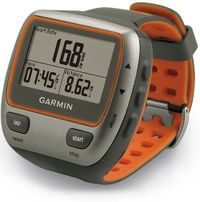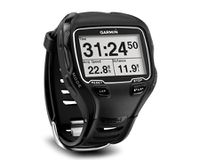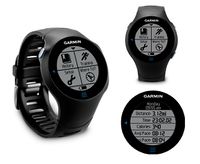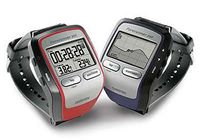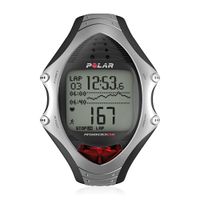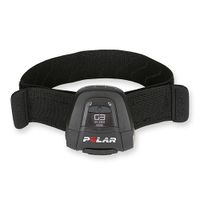Difference between revisions of "Best Running Watch"
User:Fellrnr (User talk:Fellrnr | contribs) m |
User:Fellrnr (User talk:Fellrnr | contribs) |
||
| Line 1: | Line 1: | ||
| − | A good running watch can provide valuable information while you run, as well as automating your [[The importance of a training log|training log]]. | + | A good running watch can provide valuable information while you run, as well as automating your [[The importance of a training log|training log]]. This article is a concise guide to the best running watches available today. It does not attempt to cover every watch on the market, but it does call out some to avoid. |
| − | =Summary = | + | __NOTOC__ |
| − | + | =Summary= | |
| − | + | This is a summary of my recommendations. | |
| − | + | {| class="wikitable" | |
| − | + | !Watch!!Recommendation Reason!!With Heart Rate Monitor!!Without Heart Rate Monitor!!Accessory Heart Rate Monitor!!Footpod | |
| − | + | |- | |
| − | =What to look for= | + | |Garmin 310XT||The best value for nearly every runner.||[http://go.fellrnr.com/?id=35454X937677&xs=1&xcust=BestWatch310W&url=http%3A%2F%2Fwww.amazon.com%2FGarmin-Forerunner-Waterproof-Running-Monitor%2Fdp%2FB0025VKUPM Garmin 310XT with HRM]||[http://go.fellrnr.com/?id=35454X937677&xs=1&xcust=BestWatch310N&url=http%3A%2F%2Fwww.amazon.com%2FGarmin-Forerunner-310XT-Waterproof-Running%2Fdp%2FB0025VKW5K Garmin 310XT without HRM]||[http://go.fellrnr.com/?id=35454X937677&xs=1&xcust=BestWatchHRM&url=http%3A%2F%2Fwww.amazon.com%2FGarmin-Premium-Heart-Monitor-Strap%2Fdp%2FB0029M3NSS Garmin HRM]||[http://go.fellrnr.com/?id=35454X937677&xs=1&xcust=BestWatchFootpod&url=http%3A%2F%2Fwww.amazon.com%2FGarmin-Foot-Pod-Retail-Packaging%2Fdp%2FB00264GKVQ Garmin Footpod] |
| + | |- | ||
| + | |Garmin 610||Smaller than the other recommendations.||[http://go.fellrnr.com/?id=35454X937677&xs=1&xcust=BestWatch610W&url=http%3A%2F%2Fwww.amazon.com%2FGarmin-Forerunner-Touchscreen-Watch-Monitor%2Fdp%2FB004XC3MXI Garmin 610 with HRM]||[http://go.fellrnr.com/?id=35454X937677&xs=1&xcust=BestWatch610N&url=http%3A%2F%2Fwww.amazon.com%2FGarmin-Forerunner-610-Touchscreen-Watch%2Fdp%2FB004WONCQE Garmin 610 without HRM]||[http://go.fellrnr.com/?id=35454X937677&xs=1&xcust=BestWatchHRM&url=http%3A%2F%2Fwww.amazon.com%2FGarmin-Premium-Heart-Monitor-Strap%2Fdp%2FB0029M3NSS Garmin HRM]||[http://go.fellrnr.com/?id=35454X937677&xs=1&xcust=BestWatchFootpod&url=http%3A%2F%2Fwww.amazon.com%2FGarmin-Foot-Pod-Retail-Packaging%2Fdp%2FB00264GKVQ Garmin Footpod] | ||
| + | |- | ||
| + | |Garmin 910XT||An improved version of the 310XT.<br>Better for swimmers & adds an altimeter.||[http://go.fellrnr.com/?id=35454X937677&xs=1&xcust=BestWatch&url=http%3A%2F%2Fwww.amazon.com%2FGarmin-Forerunner-910XT-GPS-Enabled-Monitor%2Fdp%2FB005T0Z9CU Garmin 910XT with HRM]||[http://go.fellrnr.com/?id=35454X937677&xs=1&xcust=BestWatch&url=http%3A%2F%2Fwww.amazon.com%2FGarmin-Forerunner-910XT-GPS-Enabled-Sport%2Fdp%2FB005SPCJ74 Garmin 910XT without HRM]||[http://go.fellrnr.com/?id=35454X937677&xs=1&xcust=BestWatchHRM&url=http%3A%2F%2Fwww.amazon.com%2FGarmin-Premium-Heart-Monitor-Strap%2Fdp%2FB0029M3NSS Garmin HRM]||[http://go.fellrnr.com/?id=35454X937677&xs=1&xcust=BestWatchFootpod&url=http%3A%2F%2Fwww.amazon.com%2FGarmin-Foot-Pod-Retail-Packaging%2Fdp%2FB00264GKVQ Garmin Footpod] | ||
| + | |- | ||
| + | |Garmin 205||Limited functionality, but cheap||Not available||[http://go.fellrnr.com/?id=35454X937677&xs=1&xcust=BestWatch205&url=http%3A%2F%2Fwww.amazon.com%2FGarmin-Forerunner-Receiver-Sports-Watch%2Fdp%2FB000CSQJ8C Garmin 205]||N/A||N/A | ||
| + | |- | ||
| + | |} | ||
| + | |||
| + | |||
| + | ==What to look for== | ||
There are several features to consider when looking for a runners watch. | There are several features to consider when looking for a runners watch. | ||
* GPS provides an easy measure of how far you've run, which is critical for your training. While it is possible to map out a run afterwards, this tends to be tedious and is typically less accurate than GPS. | * GPS provides an easy measure of how far you've run, which is critical for your training. While it is possible to map out a run afterwards, this tends to be tedious and is typically less accurate than GPS. | ||
** GPS is easy to use and accurate enough for most running, but it is not accurate enough for things like interval training. | ** GPS is easy to use and accurate enough for most running, but it is not accurate enough for things like interval training. | ||
** The errors in GPS average out over a run, but they cause a problem when trying to display current pace. | ** The errors in GPS average out over a run, but they cause a problem when trying to display current pace. | ||
| − | * A | + | * A [[FootPod]] can be used to provide [[Cadence]] and in some watches it can also provide pace and distance. Unlike GPS, [[FootPod]]s need to be calibrated to provide accurate pace/distance. |
| − | |||
* [[Heart Rate]] is important information when training, though it is important to understand the limitations of heart rate based training. Having a [[Heart Rate Monitor]] that will record your heart rate is particularly valuable for evaluating your training. The heart rate strap that goes across your chest can be intrusive and sometimes can chafe. Polar heart rate monitoring is far better than the Garmin equivalent. | * [[Heart Rate]] is important information when training, though it is important to understand the limitations of heart rate based training. Having a [[Heart Rate Monitor]] that will record your heart rate is particularly valuable for evaluating your training. The heart rate strap that goes across your chest can be intrusive and sometimes can chafe. Polar heart rate monitoring is far better than the Garmin equivalent. | ||
* The ability to record your workout and store it in a training log such as [[Dailymile]] or [[SportTracks]] is vital. All of the recommended watches here have that ability. I'd strongly advise even a new runner to store their data so that they can look back over the months and years to understand their progress. | * The ability to record your workout and store it in a training log such as [[Dailymile]] or [[SportTracks]] is vital. All of the recommended watches here have that ability. I'd strongly advise even a new runner to store their data so that they can look back over the months and years to understand their progress. | ||
| + | * An altimeter will measure the atmospheric pressure and give you altitude. This is more accurate than GPS, but will require calibration to adjust for weather related pressure changes. | ||
| + | |||
| + | ==Garmin Heart Rate Monitoring== | ||
| + | The [[Heart Rate Monitor|Heart Rate Monitoring]] of Garmin watches is not as reliable as the Polar systems, but there are [[Garmin Heart Rate Monitoring|things to can do to improve this]]. | ||
| − | =The best - Garmin 310XT= | + | =The best value - Garmin 310XT= |
| − | + | The best value watch for most runners is currently the [http://go.fellrnr.com/?id=35454X937677&xs=1&xcust=BestWatch310W&url=http%3A%2F%2Fwww.amazon.com%2FGarmin-Forerunner-Waterproof-Running-Monitor%2Fdp%2FB0025VKUPM Garmin 310XT with HRM]. It is available as the [http://www.rei.com/product/791092/garmin-forerunner-310xt-gps-fitness-monitor 310XT 'Fitness Monitor'] without the [[Heart Rate Monitor]] for $50 less. The [http://go.fellrnr.com/?id=35454X937677&xs=1&xcust=BestWatch&url=http%3A%2F%2Fwww.amazon.com%2FGarmin-Forerunner-910XT-GPS-Enabled-Monitor%2Fdp%2FB005T0Z9CU Garmin 910XT] is better, but not worth the extra cost for most runners. | |
| − | [[File:Garmin310XT.jpg|thumb| | + | [[File:Garmin310XT.jpg|thumb|none|200px|Garmin 310XT]] |
| − | ==Pros == | + | |
| − | * The 310XT is one of the most advanced watches available, but is no harder for a beginner to use than most alternatives. | + | ==Pros== |
| − | * The | + | * The 310XT is one of the most advanced watches available, but is no harder for a beginner to use than most alternatives. (It's easier than the 4xx series Garmin watches.) |
| + | * The 310XT is great value for money at this price level. | ||
| + | * A great feature is the ability to use the optional [[FootPod]] to display your current pace while using GPS for overall pace, distance and route. Only the 310XT, 910XT and Garmin 610 can do this. | ||
* The GPS is more accurate than earlier watches, and has a faster startup time. (It uses the SiRFstar III with Instafix, one of the latest GPS chipsets) | * The GPS is more accurate than earlier watches, and has a faster startup time. (It uses the SiRFstar III with Instafix, one of the latest GPS chipsets) | ||
* The housing is fully waterproof (to 50m/160ft), so running in the rain is no problem. | * The housing is fully waterproof (to 50m/160ft), so running in the rain is no problem. | ||
| Line 27: | Line 43: | ||
* The display is big enough to show four readings. I often display current pace, average pace for the current lap, average pace for the run and either heart rate or distance. | * The display is big enough to show four readings. I often display current pace, average pace for the current lap, average pace for the run and either heart rate or distance. | ||
* You can upload courses and display them. This is great when running somewhere unfamiliar. | * You can upload courses and display them. This is great when running somewhere unfamiliar. | ||
| − | * There are several optional extras for the 310XT, including the already mentioned | + | * There are several optional extras for the 310XT, including the already mentioned [[FootPod]] and heart rate strap. For cyclists there is also a [http://go.fellrnr.com/?id=35454X937677&xs=1&xcust=BestWatch&url=http%3A%2F%2Fwww.amazon.com%2FGarmin-Speed-Cadence-Bike-Sensor%2Fdp%2FB000BFNOT8 speed/cadence sensor] and it works with various power sensors. |
* The vibration alert works nicely. I often run with the 310XT set to record a lap every mile, and it will vibrate as well as beep. | * The vibration alert works nicely. I often run with the 310XT set to record a lap every mile, and it will vibrate as well as beep. | ||
| + | |||
==Cons== | ==Cons== | ||
| − | |||
* Some people find the 310XT to be rather large, and it is much larger than a normal watch. | * Some people find the 310XT to be rather large, and it is much larger than a normal watch. | ||
| − | * The battery life is good for about 16-20 hours, which is enough for most people. Ultrarunners doing 100 mile or longer races will find this a problem. | + | * The battery life is good for about 16-20 hours, which is enough for most people. Ultrarunners doing 100 mile or longer races will find this a problem, though it is possible to recharge it while in use. |
| − | + | * For races where the GPS track is not important, you can extend the battery life by turning off the GPS receiver and use the [[FootPod]]. After 12 hours of running I still had 85% of the battery left. If you're running on a reasonable smooth surface, the [[FootPod]] is often more accurate than GPS. | |
| − | + | ||
| + | =The Best – Garmin 910XT= | ||
| + | The [http://go.fellrnr.com/?id=35454X937677&xs=1&xcust=BestWatch&url=http%3A%2F%2Fwww.amazon.com%2FGarmin-Forerunner-910XT-GPS-Enabled-Monitor%2Fdp%2FB005T0Z9CU Garmin 910XT with HRM] is an improved version of the 310XT, but it's about $100 more expensive. It can record laps when swimming, and is better at recording altitude, and it's recommended if you need those features. If you don't need them, then the 310XT is better value. (It's available without the [[Heart Rate Monitor]] as [http://go.fellrnr.com/?id=35454X937677&xs=1&xcust=BestWatch&url=http%3A%2F%2Fwww.amazon.com%2FGarmin-Forerunner-910XT-GPS-Enabled-Sport%2Fdp%2FB005SPCJ74 Garmin 910XT without HRM].) Nearly all of the pros and cons of the 310XT apply to the 910XT, so I won't repeat them here. | ||
| + | [[File:Garmin-910xt.jpg|thumb|none|200px|Garmin 910XT]] | ||
| − | |||
| − | |||
| − | |||
==Pros== | ==Pros== | ||
| − | * | + | * The 910XT can record swimming, but it does this with an accelerometer rather than GPS. You have to tell the 910XT how long the pool is, but it will detect each lap, as well as your stroke. |
| − | * | + | * The 910XT has a barometric altimeter, which is far more accurate at recording altitude changes than GPS. |
| + | |||
==Cons== | ==Cons== | ||
| − | * The | + | * The biggest downside for most people is the price, which is $100 more than the 310XT. |
| − | * | + | * While the 910XT is slightly slimmer than the 310XT, it is still rather large, and it is much larger than a normal watch. |
| − | + | ||
| − | |||
=Smaller – Garmin 610= | =Smaller – Garmin 610= | ||
| − | The [http:// | + | The [http://go.fellrnr.com/?id=35454X937677&xs=1&xcust=BestWatch610W&url=http%3A%2F%2Fwww.amazon.com%2FGarmin-Forerunner-Touchscreen-Watch-Monitor%2Fdp%2FB004XC3MXI Garmin 610 with HRM] is a new watch from Garmin that is smaller, but overcomes many of the issues seen in the 4xx range (see below). |
| − | [[File:Garmin610.jpg|thumb| | + | [[File:Garmin610.jpg|thumb|none|200px|Garmin 610]] |
| + | |||
==Pros== | ==Pros== | ||
* Smaller than the 310XT/305/205 and closer to the size of a traditional watch. | * Smaller than the 310XT/305/205 and closer to the size of a traditional watch. | ||
| + | * Like the 310XT, it can use the optional [[FootPod]] to display your current pace while using GPS for overall pace, distance and route. Only the 310XT, 910XT and 610 can do this (so far). | ||
* The touchscreen interface works with gloves and in the rain, unlike most touchscreens found on phones or media players. | * The touchscreen interface works with gloves and in the rain, unlike most touchscreens found on phones or media players. | ||
* Good GPS accuracy (uses the SiRF SiRFstarIV with the Instant Fix II) | * Good GPS accuracy (uses the SiRF SiRFstarIV with the Instant Fix II) | ||
| + | |||
==Cons== | ==Cons== | ||
* The battery life is rather short. It is claimed to provide 8 hours, but based on experience with other Garmin devices, the actual live may be quite a bit less. This is likely to cause an issue for slower marathon runners or ultrarunners. | * The battery life is rather short. It is claimed to provide 8 hours, but based on experience with other Garmin devices, the actual live may be quite a bit less. This is likely to cause an issue for slower marathon runners or ultrarunners. | ||
* The price is quite high, listing at $350 or $400 including the heart rate monitor. | * The price is quite high, listing at $350 or $400 including the heart rate monitor. | ||
| − | * Not the range of accessories that the 310XT has, such as power meter for cycling. | + | * Not the range of accessories that the 910XT/310XT has, such as power meter for cycling. |
* No display of course maps. | * No display of course maps. | ||
| − | = | + | |
| − | [[File:PolarRS800CX.jpg|thumb| | + | =Cheaper - Garmin 205= |
| − | I used Polar systems for many years and their quality is great. However, I find the convenience of the Garmin GPS systems to be superior and I | + | The [http://go.fellrnr.com/?id=35454X937677&xs=1&xcust=BestWatch305&url=http%3A%2F%2Fwww.amazon.com%2FGarmin-Forerunner-Receiver-Heart-Monitor%2Fdp%2FB000CSWCQA Garmin 305] and the [http://go.fellrnr.com/?id=35454X937677&xs=1&xcust=BestWatch205&url=http%3A%2F%2Fwww.amazon.com%2FGarmin-Forerunner-Receiver-Sports-Watch%2Fdp%2FB000CSQJ8C Garmin 205] are the predecessors to the 310XT and are quite similar in a number of ways. The 305 has a few extra features over the 205, such as the heart rate monitor and support for a [[FootPod]]. The 205 is quite cheap, but the 305 is now more expensive than the 310XT and nowhere near as good. |
| + | [[File:Garmin305.jpg|thumb|none|200px|Garmin 305 with 205 on the right]] | ||
| + | |||
| + | ==Pros== | ||
| + | * The [http://go.fellrnr.com/?id=35454X937677&xs=1&xcust=BestWatch205&url=http%3A%2F%2Fwww.amazon.com%2FGarmin-Forerunner-Receiver-Sports-Watch%2Fdp%2FB000CSQJ8C Garmin 205] is cheap. | ||
| + | * Usability, display size and course display are similar to the 310XT. | ||
| + | |||
| + | ==Cons== | ||
| + | * The battery life is quite a bit shorter than the 310XT (6-10 hours), though still good enough for many runners. | ||
| + | * The GPS is not as accurate or as fast as the 310XT. | ||
| + | * They're not fully waterproof, but I never had a problem in the rain. | ||
| + | * The 205 does not work as a [[Heart Rate Monitor]], something I believe is important. | ||
| + | |||
| + | =If you need Heart Rate Variability – Polar RS800CX= | ||
| + | [[File:PolarRS800CX.jpg|thumb|none|200px|Polar RS800CX]] | ||
| + | I used Polar systems for many years and their quality is great. However, I find the convenience of the Garmin GPS systems to be superior and I would no longer recommend the [http://go.fellrnr.com/?id=35454X937677&xs=1&xcust=BestWatchRS800&url=http%3A%2F%2Fwww.amazon.com%2FPolar-RS800CX-Heart-Rate-Monitor%2Fdp%2FB003G3YBR6 Polar RS800CX] unless you need a first rate [Heart Rate Monitor]] that will display [[Heart Rate Variability]]. | ||
| + | |||
==Pros== | ==Pros== | ||
| − | + | * Heart rate monitoring is far better than with Garmin. The RS800CX will even record each individual heart beat for analyzing [[Heart Rate Variability]], though few people will ever make use of that feature. | |
| − | * Heart rate monitoring is far better than with Garmin. The RS800CX will even record each individual heart beat for analyzing | + | * The battery life of the RS800CX is measured in months not hours. This should not be an issue for most runners. |
* The RS800CX is the size of a conventional watch, and because of the long battery life, it can be used as one. | * The RS800CX is the size of a conventional watch, and because of the long battery life, it can be used as one. | ||
* Includes a barometer for altitude (GPS has very poor accuracy for altitude). | * Includes a barometer for altitude (GPS has very poor accuracy for altitude). | ||
| + | * There is a Polar [[FootPod]], the [http://go.fellrnr.com/?id=35454X937677&xs=1&xcust=BestWatchS3P&url=http%3A%2F%2Fwww.amazon.com%2FPolar-91039283-S3-Stride-Sensor%2Fdp%2FB005RXZ1YU Polar S3+ Stride Sensor], which works nearly as well as the Garmin equivalent, but it's larger and more expensive. | ||
* Fully waterproof. | * Fully waterproof. | ||
| + | |||
==Cons== | ==Cons== | ||
* It's Expensive at around $370. | * It's Expensive at around $370. | ||
| − | * While the RS800CX can support GPS, it requires an add-on box you strap to your arm, which is a rather | + | * While the RS800CX can support GPS, it requires [http://go.fellrnr.com/?id=35454X937677&xs=1&xcust=BestWatchGPS5&url=http%3A%2F%2Fwww.amazon.com%2FPolar-G5-GPS-Sensor-Set%2Fdp%2FB005F5J3JY an add-on GPS box] you strap to your arm, which is a rather poor solution. The GPS has a battery life of only 20 hours and requires recharging. |
| − | * There is no display of course maps | + | * There is no display of course maps. |
| + | * This is a [[Heart Rate Monitor]] and it objects if you try to use it without the monitor. | ||
[[File:PolarG3.jpg|thumb|none|200px|The rather clunky GPS and arm band]] | [[File:PolarG3.jpg|thumb|none|200px|The rather clunky GPS and arm band]] | ||
| + | |||
=Not Recommended - Garmin 405/405CX/410= | =Not Recommended - Garmin 405/405CX/410= | ||
| − | The Garmin 4xx series watches use a touch sensitive bezel which does not work well with gloves or when wet. The [http://go.fellrnr.com?id=35454X937677&xs=1&url=http%3A%2F%2Fwww. | + | The Garmin 4xx series watches use a touch sensitive bezel which does not work well with gloves or when wet. The [http://go.fellrnr.com/?id=35454X937677&xs=1&xcust=BestWatchG410&url=http%3A%2F%2Fwww.amazon.com%2FGarmin-Forerunner-GPS-Enabled-Sports-Watch%2Fdp%2FB0046BWRUK Garmin 410] has an 'improved bezel', but there are [http://www.dcrainmaker.com/2011/01/look-at-new-garmin-fr410-touch-bezel.html still problems]. I also see more people struggling at the start of marathons with the 4xx watches than all the other devices combined. |
| + | |||
=Not Recommended - Nike+ Sportwatch= | =Not Recommended - Nike+ Sportwatch= | ||
| − | There is a lot to like about the Nike+ Sportwatch, but it has one weakness that I believe is unacceptable. The software for the Nike+ does not allow you to use the data from your runs in anything other than the Nike web site. A [[The importance of a training log|training log is important]], and while beginners may not need one, buying a watch that prevents you from accessing your data in the future is too limiting. If you're still interested, have a read of [http://www.dcrainmaker.com/2011/04/nike-sportwatch-gps-in-depth-review.html DC Rainmaker's review] | + | There is a lot to like about the Nike+ Sportwatch, but it has one weakness that I believe is unacceptable. The software for the Nike+ does not allow you to use the data from your runs in anything other than the Nike web site. A [[The importance of a training log|training log is important]], and while beginners may not need one, buying a watch that prevents you from accessing your data in the future is too limiting. If you're still interested, have a read of [http://www.dcrainmaker.com/2011/04/nike-sportwatch-gps-in-depth-review.html DC Rainmaker's review]. |
Revision as of 07:51, 14 August 2012
A good running watch can provide valuable information while you run, as well as automating your training log. This article is a concise guide to the best running watches available today. It does not attempt to cover every watch on the market, but it does call out some to avoid.
1 Summary
This is a summary of my recommendations.
| Watch | Recommendation Reason | With Heart Rate Monitor | Without Heart Rate Monitor | Accessory Heart Rate Monitor | Footpod |
|---|---|---|---|---|---|
| Garmin 310XT | The best value for nearly every runner. | Garmin 310XT with HRM | Garmin 310XT without HRM | Garmin HRM | Garmin Footpod |
| Garmin 610 | Smaller than the other recommendations. | Garmin 610 with HRM | Garmin 610 without HRM | Garmin HRM | Garmin Footpod |
| Garmin 910XT | An improved version of the 310XT. Better for swimmers & adds an altimeter. |
Garmin 910XT with HRM | Garmin 910XT without HRM | Garmin HRM | Garmin Footpod |
| Garmin 205 | Limited functionality, but cheap | Not available | Garmin 205 | N/A | N/A |
1.1 What to look for
There are several features to consider when looking for a runners watch.
- GPS provides an easy measure of how far you've run, which is critical for your training. While it is possible to map out a run afterwards, this tends to be tedious and is typically less accurate than GPS.
- GPS is easy to use and accurate enough for most running, but it is not accurate enough for things like interval training.
- The errors in GPS average out over a run, but they cause a problem when trying to display current pace.
- A FootPod can be used to provide Cadence and in some watches it can also provide pace and distance. Unlike GPS, FootPods need to be calibrated to provide accurate pace/distance.
- Heart Rate is important information when training, though it is important to understand the limitations of heart rate based training. Having a Heart Rate Monitor that will record your heart rate is particularly valuable for evaluating your training. The heart rate strap that goes across your chest can be intrusive and sometimes can chafe. Polar heart rate monitoring is far better than the Garmin equivalent.
- The ability to record your workout and store it in a training log such as Dailymile or SportTracks is vital. All of the recommended watches here have that ability. I'd strongly advise even a new runner to store their data so that they can look back over the months and years to understand their progress.
- An altimeter will measure the atmospheric pressure and give you altitude. This is more accurate than GPS, but will require calibration to adjust for weather related pressure changes.
1.2 Garmin Heart Rate Monitoring
The Heart Rate Monitoring of Garmin watches is not as reliable as the Polar systems, but there are things to can do to improve this.
2 The best value - Garmin 310XT
The best value watch for most runners is currently the Garmin 310XT with HRM. It is available as the 310XT 'Fitness Monitor' without the Heart Rate Monitor for $50 less. The Garmin 910XT is better, but not worth the extra cost for most runners.
2.1 Pros
- The 310XT is one of the most advanced watches available, but is no harder for a beginner to use than most alternatives. (It's easier than the 4xx series Garmin watches.)
- The 310XT is great value for money at this price level.
- A great feature is the ability to use the optional FootPod to display your current pace while using GPS for overall pace, distance and route. Only the 310XT, 910XT and Garmin 610 can do this.
- The GPS is more accurate than earlier watches, and has a faster startup time. (It uses the SiRFstar III with Instafix, one of the latest GPS chipsets)
- The housing is fully waterproof (to 50m/160ft), so running in the rain is no problem.
- Connection to a PC is wireless, using a USB adapter. This is less hassle than any of the other options I've tried.
- The display is big enough to show four readings. I often display current pace, average pace for the current lap, average pace for the run and either heart rate or distance.
- You can upload courses and display them. This is great when running somewhere unfamiliar.
- There are several optional extras for the 310XT, including the already mentioned FootPod and heart rate strap. For cyclists there is also a speed/cadence sensor and it works with various power sensors.
- The vibration alert works nicely. I often run with the 310XT set to record a lap every mile, and it will vibrate as well as beep.
2.2 Cons
- Some people find the 310XT to be rather large, and it is much larger than a normal watch.
- The battery life is good for about 16-20 hours, which is enough for most people. Ultrarunners doing 100 mile or longer races will find this a problem, though it is possible to recharge it while in use.
- For races where the GPS track is not important, you can extend the battery life by turning off the GPS receiver and use the FootPod. After 12 hours of running I still had 85% of the battery left. If you're running on a reasonable smooth surface, the FootPod is often more accurate than GPS.
3 The Best – Garmin 910XT
The Garmin 910XT with HRM is an improved version of the 310XT, but it's about $100 more expensive. It can record laps when swimming, and is better at recording altitude, and it's recommended if you need those features. If you don't need them, then the 310XT is better value. (It's available without the Heart Rate Monitor as Garmin 910XT without HRM.) Nearly all of the pros and cons of the 310XT apply to the 910XT, so I won't repeat them here.
3.1 Pros
- The 910XT can record swimming, but it does this with an accelerometer rather than GPS. You have to tell the 910XT how long the pool is, but it will detect each lap, as well as your stroke.
- The 910XT has a barometric altimeter, which is far more accurate at recording altitude changes than GPS.
3.2 Cons
- The biggest downside for most people is the price, which is $100 more than the 310XT.
- While the 910XT is slightly slimmer than the 310XT, it is still rather large, and it is much larger than a normal watch.
4 Smaller – Garmin 610
The Garmin 610 with HRM is a new watch from Garmin that is smaller, but overcomes many of the issues seen in the 4xx range (see below).
4.1 Pros
- Smaller than the 310XT/305/205 and closer to the size of a traditional watch.
- Like the 310XT, it can use the optional FootPod to display your current pace while using GPS for overall pace, distance and route. Only the 310XT, 910XT and 610 can do this (so far).
- The touchscreen interface works with gloves and in the rain, unlike most touchscreens found on phones or media players.
- Good GPS accuracy (uses the SiRF SiRFstarIV with the Instant Fix II)
4.2 Cons
- The battery life is rather short. It is claimed to provide 8 hours, but based on experience with other Garmin devices, the actual live may be quite a bit less. This is likely to cause an issue for slower marathon runners or ultrarunners.
- The price is quite high, listing at $350 or $400 including the heart rate monitor.
- Not the range of accessories that the 910XT/310XT has, such as power meter for cycling.
- No display of course maps.
5 Cheaper - Garmin 205
The Garmin 305 and the Garmin 205 are the predecessors to the 310XT and are quite similar in a number of ways. The 305 has a few extra features over the 205, such as the heart rate monitor and support for a FootPod. The 205 is quite cheap, but the 305 is now more expensive than the 310XT and nowhere near as good.
5.1 Pros
- The Garmin 205 is cheap.
- Usability, display size and course display are similar to the 310XT.
5.2 Cons
- The battery life is quite a bit shorter than the 310XT (6-10 hours), though still good enough for many runners.
- The GPS is not as accurate or as fast as the 310XT.
- They're not fully waterproof, but I never had a problem in the rain.
- The 205 does not work as a Heart Rate Monitor, something I believe is important.
6 If you need Heart Rate Variability – Polar RS800CX
I used Polar systems for many years and their quality is great. However, I find the convenience of the Garmin GPS systems to be superior and I would no longer recommend the Polar RS800CX unless you need a first rate [Heart Rate Monitor]] that will display Heart Rate Variability.
6.1 Pros
- Heart rate monitoring is far better than with Garmin. The RS800CX will even record each individual heart beat for analyzing Heart Rate Variability, though few people will ever make use of that feature.
- The battery life of the RS800CX is measured in months not hours. This should not be an issue for most runners.
- The RS800CX is the size of a conventional watch, and because of the long battery life, it can be used as one.
- Includes a barometer for altitude (GPS has very poor accuracy for altitude).
- There is a Polar FootPod, the Polar S3+ Stride Sensor, which works nearly as well as the Garmin equivalent, but it's larger and more expensive.
- Fully waterproof.
6.2 Cons
- It's Expensive at around $370.
- While the RS800CX can support GPS, it requires an add-on GPS box you strap to your arm, which is a rather poor solution. The GPS has a battery life of only 20 hours and requires recharging.
- There is no display of course maps.
- This is a Heart Rate Monitor and it objects if you try to use it without the monitor.
7 Not Recommended - Garmin 405/405CX/410
The Garmin 4xx series watches use a touch sensitive bezel which does not work well with gloves or when wet. The Garmin 410 has an 'improved bezel', but there are still problems. I also see more people struggling at the start of marathons with the 4xx watches than all the other devices combined.
8 Not Recommended - Nike+ Sportwatch
There is a lot to like about the Nike+ Sportwatch, but it has one weakness that I believe is unacceptable. The software for the Nike+ does not allow you to use the data from your runs in anything other than the Nike web site. A training log is important, and while beginners may not need one, buying a watch that prevents you from accessing your data in the future is too limiting. If you're still interested, have a read of DC Rainmaker's review.
